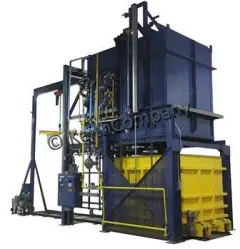Gas Fired Drop Bottom Furnaces
If AMS, BAC, RPS or Milspec process specifications for solution heat treating aluminum allows for products of combustion in the air stream, then a direct gas fired furnace is the most economic choice. If no products of combustion are allowed in the air stream, then an indirect fuel gas fired or electric heated furnace must be used. Our furnaces and ovens meet class 1 requirements of AMS 2750G (previously AMS 2750F), NADCAP AS7102, MILSPEC H6088, BAC 5621, Rolls Royce RPS 953 and DPS 1.700.
Gas fired drop bottom furnaces can reduce energy cost by a factor of four. AQMD rule 219 exempts heat treat equipment with less than 2 Mio Btu heat input per hour from obtaining an air contamination permit; if the heat input is above 2 Mio Btu per hour, AQMD rule 1147 specifies a NOx limit of 60ppm for metal heat treat furnaces. Aluminum solution heat treating of castings (AMS 2771) requires typcically more heat input then solution heat treating of wrought aluminum (AMS 2770) or raw aluminum alloys (AMS 2772), but loads of less than 1,500 lbs rarely require heat inputs of above 2 Mio Btu per hour.
Direct gas firing:
Gas burners are firing directly into the heating chamber from where a fan transports the heated air into the furnace chamber.
Indirect gas firing:
The load is heated by convection. Gas burners heat up a gas tight firing tube positioned in the airstream generated by a fan. The combustion gases are exhausted directly into a duct. The furnace chamber is designed as a downdraft system, meaning the hot air enters the top of the chamber and exits at the bottom of the chamber. This design has the advantage that potentially cold air (entering through worn out seals on the bottom door) is first pulled into the heating chamber where it is mixed with the air from the furnace chamber. This results in greater temperature uniformity in the furnace chamber.
- AMS 2770, 2771, 2772 aluminum heat treating process specifications
- AMS2750 TUS measurement example for bottom drop oven 48x48x60
- AMS-2750G System-Accuracy-Testing SAT & Temperature Uniformity Survey TUS
- Aluminum Solution Heat Treat Definitions
- Characteristics of Cast Aluminum Alloys Series
- Air Quality Management District - Rule 219
- Air Quality Management District - Rule 1147











